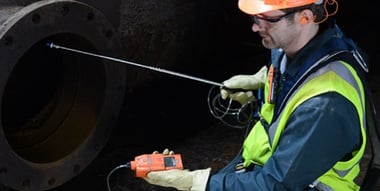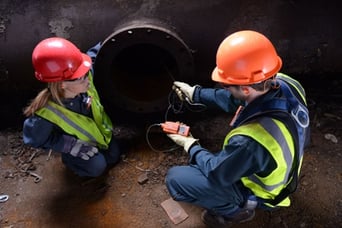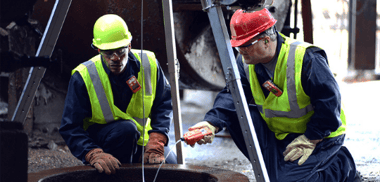While it's often necessary for workers to enter confined spaces, the nature of these spaces presents special challenges and dangers that workers must be prepared to confront.
OSHA estimates that confined spaces are responsible for about 200 deaths each year, around 60% of which are would-be rescuers, or those who were attempting to help another person. Low oxygen levels are the most common gas-related cause of death in confined spaces.
So how can you reduce the risk of working in confined spaces?
Managing Gas Hazards in Confined Spaces
No two confined spaces are the same, but they all have the potential to harm workers if you don’t identify, monitor, and control the dangers within.
A safe confined space monitoring strategy requires a great deal of teamwork. Supervisors need to ensure that workers (including contractors) understand the hazards of the space and that they have the safety and communication tools they need.
If you’re responsible for managing confined spaces, take these three critical steps to ensure worker safety.
1. Plan Ahead
Before workers enter a confined space, supervisors must complete a risk assessment (examining the environment in/around the confined space for entry location and size, energy or chemical sources, and lockout points), hazard assessment (examining what hazards workers could be exposed to), identify the personal protective equipment workers will need, and select properly-trained workers to perform the job.
The results of these assessments will determine how your workers will perform the job. If you don't have staff that has been trained to conduct a complete site assessment, you should consult a third-party.
2. Test Atmosphere
Standards around the world require workers to test the atmosphere with a confined space monitor prior to entering a confined space. Although there are a few different ways to conduct pre-entry testing, the recognized best practice is to use a portable gas monitor equipped with a remote sampling pump. When the pre-entry testing is complete, it is also a best practice—and a requirement of some standards—to continuously monitor the atmosphere inside the space throughout the entry.
Pumped gas detectors, like the Ventis® Pro5, Ventis® MX4, MX6 iBrid®, and the Radius® BZ1 Area Monitor, allow users to take samples of a space before entering and continuously monitor the space throughout the work. Although traditional confined space atmospheric testing calls for a hand-held portable instrument, the Radius BZ1 Area Monitor can reduce the costs and increase the efficiency and safety of confined space operations, particularly those calling for extended, continuous monitoring.
3. Communicate
After pre-entry testing, confined spaces must also be monitored by an attendant. One attendant can serve multiple confined spaces, as long as he or she can monitor the atmosphere and communicate with the entrants in all of the spaces.
As you can imagine, this can sometimes make it difficult for the worker inside to communicate with the attendant. The concern here is that the atmosphere inside the confined space can change quickly and unexpectedly. But if the worker inside the space doesn’t have a monitor, and the attendant is addressing an issue within another confined space, that worker could be in grave danger. The safest practice, therefore, is for a worker within the confined space to have a personal monitor that can share gas readings to the attendant’s monitor. If a worker inside the confined space encounters a gas hazard, is immobilized, or needs emergency assistance for any other reason, the cause of the alarm is instantly relayed to the attendant’s gas detector.
As unfortunate as it is, injuries and even death are not uncommon in confined spaces. To make matters worse, additional deaths can occur if rescuers attempt to help a worker in need, only to be overcome by those same atmospheric hazards. You can help prevent would-be rescuer tragedies by using gas detectors that can automatically share gas readings and alarms, so all workers know when a peer needs help and what conditions they’re facing.
Improving Your Confined Space Entry Plan
Making sure that your workers are safe is one of your most important jobs. Our team is here to help you evaluate whether your current safety procedures will alert workers to gas hazards. Speak to a gas detection expert today to review your gas detection program.



